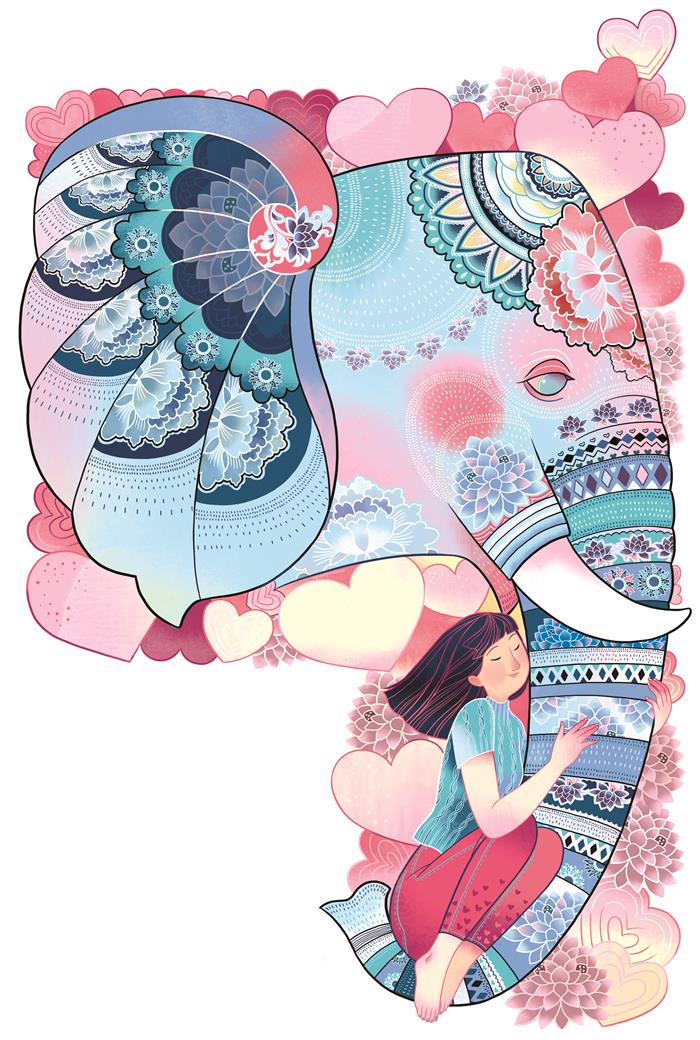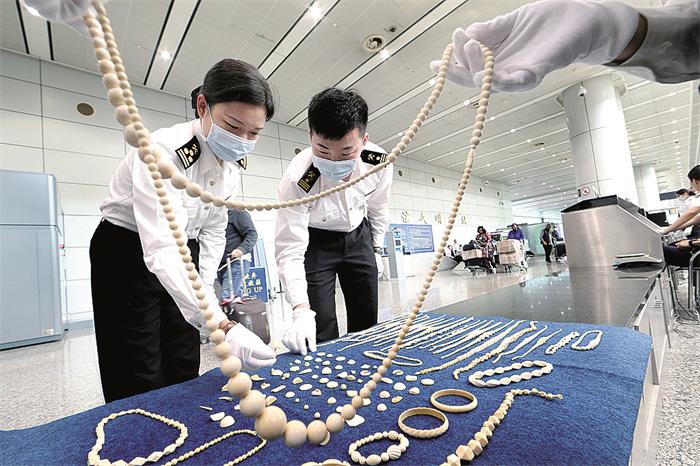Halting ivory


Weekends are the busiest time for sellers in the Panjiayuan Antique Market, the largest and most popular antiques market in Beijing. Thousands of potential buyers wander through hundreds of small shops in the market, hunting for treasures.
Among them recently was Wang Yuesheng, a 58-year-old Beijing resident, who was looking for precious jewelry as a gift for his 88-year-old mother. Instead of sparkling gems or traditional gold or silver accessories, Wang planned to find a carved ivory art piece.
"Ivory is believed in many Asian countries to be an auspicious material that is used in religious sculptures. And the ivory carvings, with beautiful sculptured forms such as flowers and the god of longevity, convey lots of good wishes in an elegant way," he said.
However, Wang's half-day visit to Panjiayuan ended in vain, because he had not followed the recent news reports about China's ban on the sale and processing of ivory. The ban came into force on Dec 31 and has already had an effect on business in the market.
In early 2017, the State Forestry and Grassland Administration, which manages the ivory trade, announced that all commercial ivory processing and trading would be banned within the year. All of the country's about 150 ivory processing factories and sales outlets had been shut down before the deadline, including the three shops that used to sell ivory products in Panjiayuan.

The international community has hailed the ban as a move that could help to eradicate poaching and reverse the decline in the number of African elephants in the wild — now estimated by the conservation organization World Wildlife Fund to number between 450,000 and 700,000 — whose tusks are longer and more workable than those of their Asian counterparts, and therefore more valuable.
"China has shown great leadership on this urgent issue within a region plagued by illegal wildlife trade activity, which is exacerbated by legal markets. It is a huge step forward and a clear commitment to securing a future for Africa's elephants," says Margaret Kinnaird, wildlife practice leader for the World Wildlife Fund.
"The next few months will be critical for the ban to be effectively enforced and communicated. We remain confident that as the doors to the largest legal ivory trade close, we start 2018 a step closer to securing a world where demand for ivory is significantly reduced," she says.
Julius Kamau, executive director of the East African Wild Life Society, says that if the ban is effectively enforced, it will be a milestone and a success in reducing the demand for illegal wildlife products from Africa, mainly rhinoceros horns and ivory.
"China has been one of the main markets for illegal wildlife products, so with the ban, there is a high likelihood that conservation and protection of wildlife in Africa will positively be impacted," he says.
However, for the best results, other Asian markets like Vietnam should follow China's move to ban the ivory trade, Kamau says.
"The markets for all the illegal wildlife products must be halted in order to reduce the demand. Additionally, all ban pronouncements must be accompanied by effective enforcement and compliance. Nations must work together and pull in the same direction with regard to fighting this vice," he says.
Steve Itela, director of operations and partnerships for the Africa Network for Animal Welfare, applauds the move by the Chinese government to end the ivory trade, saying the government has played a crucial role in reversing the rapid decline of Africa's elephant population.
However, Itela says the Chinese government will have to work harder, through strictly enforcing rules, to ensure that no illegal ivory finds its way to the country. He says emerging trends indicate illegal ivory is still heading to China via Laos.
In addition, conservationists say the illegal wildlife trade continues on social media and other internet platforms.
"The ban is a response to pressure, but I am not sure if it will end the ivory trade in China," says Itela. "Both legal and illegal trade in ivory have existed alongside previously, and China needs to increase enforcement of this decision to close both legal and illegal markets."
Itela adds that the ivory trade ban by the Chinese government will not end wildlife poaching in Africa, because legal markets still exist in the United Kingdom and the United States.
The legal ivory trade continues in southern Africa, while in East Africa, the illegal trade is still prevalent, with Kenya, Tanzania and Uganda used as transit routes, he says. The good news is that Botswana is in the process of banning the ivory trade and adopting Kenya's position with regard to such trade, he adds.
During the 2016 Giants Club Summit, a forum that promotes wildlife protection, Kenyan President Uhuru Kenyatta pledged to eradicate elephant poaching and the illegal ivory trade in his country.
Immediately after the summit, Kenyatta sent a strong signal against poaching by burning 105 tons of ivory. Additionally, 1.5 tons of rhino horns, exotic animal skins and other products such as sandalwood and medicinal bark were burned.
Despite such efforts, Itela says that as long as ivory is valued, the ivory trade will continue, whether legal or illegal. He advocates effective detection and surveillance methods to end poaching and illegal trading.
"Africa needs a lot of resources to achieve this. Through the deepening relationship between China and Africa, the former can help the continent to end both poaching and the illegal trade," he says.
Iteta says poachers are getting smarter in concealment methods, while law enforcement agencies are not yet fully equipped to increase enforcement efforts.
"On a continent where corruption exists, it's very hard to end the ivory trade," Itela says.
He says the lasting solution for elephant and rhino conservation in Africa is to create awareness among the general public and the media that the magnificent species should be kept alive for a healthy environment.
"We urgently need to address human conflict issues related to loss of life and crops as well as loss of space for wildlife, which is now under threat from infrastructure development projects. Environmental impact assessment alone cannot protect the environment; we need individual commitment from construction companies to help us reverse the loss of space and fight wildlife crime," he says.
Under the Convention on International Trade in Endangered Species of Wild Fauna and Flora, or CITES — an international agreement among governments — African countries have been urged since 1989 to burn all ivory confiscated from poachers as a way of protecting rhinos and elephants. However, poaching has continued.
Itela says CITES deals with international trade in endangered species and does not serve Africa's interests. "CITES alone cannot end the ivory trade, as their mandate is to ensure international trade does not bring about extinction of species. CITES serves the global interests of endangered species and not traders. Without good leadership of the CITES secretariat, many species would be extinct by now," he says.
Last year, the wildlife trade monitoring network TRAFFIC and the WWF conducted a survey that found public awareness of the regulation of ivory products' processing and trade was still low. Among the 2,000 total survey respondents in 15 cities in China, only 19 percent were aware of regulation of the ivory trade, while 46 percent could recall the ban once they were prompted.
It also found that many people didn't know that only a limited number of retailers are legally entitled to sell ivory products. Many were also unaware that legal ivory products are always accompanied by a certificate that notes the product's weight, size, shape and registered code.
According to the WWF, poachers kill 20,000 to 30,000 African elephants each year for their tusks. Asian elephants are also threatened, but on a smaller scale. While Europe is the primary legal exporter of ivory, the Chinese mainland and the United States are two of the biggest markets, along with Thailand, Hong Kong and Japan.
In recent decades, China has taken measures to fight the illegal ivory trade. Since 2002, annual monitoring by CITES has consistently identified China as the world's leading destination for ivory.
To protect wild elephants, strict control of the commercial use of tusks also gained international consensus. In 2008, more than $15 million was raised for African elephant conservation and local communities through the sale of 102 metric tons of stockpiled ivory.
The ivory that was sold was all from legal, government-owned stocks, mostly from elephants that died of natural causes during the past 20 years or were culled before 1994 as part of a population control program. The sales were unanimously authorized by the 172 member states of CITES, and all of the tusks sold in the auction were from elephants that died of natural causes.
China purchased 62 tons of ivory in the sale and allowed just 5 tons of tusks to be used each year, so artisans in China have worked with legal ivory for the past nine years.
Moreover, the State Forestry and Grassland Administration had regulated the market for legal ivory by designating businesses and premises for ivory processing and trade. A certificate was required to accompany each ivory item when sold or on display.
According to Meng Xianlin, director of the administration's Endangered Species Office, apart from 70 tons of illegal tusks intercepted in smuggling cases, there are now 40 tons of legal tusks in stock on the mainland that have not been carved, and the government hasn't figured out what to do with them.
"There are many leftover problems after the ban, including the compensation or policy of redemption to the ivory companies, the protection of ivory carving skills as an intangible cultural heritage, and also creating jobs for worker laid off because of the ban," Meng says.
In the decades following the founding of the People's Republic of China, ivory carving was encouraged as one of the few means of earning foreign currency. In May 2006, ivory carving was included on the first National List of Intangible Cultural Heritage.
Unlike many other forms of craftsmanship, ivory carving takes a long time to learn because of the complicated shapes and the cost of the material, which can be ruined by one slight flaw. Many carvers began learning their trade at a young age.
However, China's efforts to reduce the industry and put the ivory trade under strict surveillance have seen the number of craftsmen fall significantly in recent years, and the national ban became, in the words of one longtime artisan, a "death sentence" for the work of many craftsmen who have worked with legal tusks.
The Beijing Ivory Carving Factory was one of the country's largest ivory businesses, and from the 1960s to the 1980s, it employed about 800 people.
Zhang Shuzhong, 54, is one of 30 craftsmen still working at the factory. He started learning the skill at age 16, taught by Yang Shijun, who is known as "Flower Master Yang" because of a series of exquisite flower carvings he made in the 1950s.
Zhang describes the announcement of the ban on all domestic ivory trading and processing as a "life-threatening" change. He says neither a national ban nor calls for elephant protection are convincing justifications for the end of craftsmanship.
"Elephants die naturally every year. To me, making their tusks into pieces of art is a form of rebirth, a renewal of their lives. Since we've adhered to the international convention and only worked with legal ivory, why is our work still tagged as an art form based on elephant deaths?" he says.
At the end of last year, the Guangzhou Daxin Ivory Carving Factory in Guangdong province employed 30 ivory carvers. However, due to the ban, the positions of 18 were eliminated earlier this year, leaving just 12 full-time employees.
Weng Zhanxuan, a sixth-generation ivory carver in Guangzhou, is one of the few remaining employees at the factory, but he is no longer allowed to use his skills.
Weng's family has been making ivory balls for about 200 years. "For a long time, my family has earned a humble living by carving ivory balls. We strongly believe in passing on our skills, but now we can only see the end of the line," he says.
"We don't know what will happen in the future, and no work can be done at the factory. Having nothing to do makes us feel even worse. The factory pays us 1,600 yuan ($250) a month, which is barely a living wage in Guangzhou," Weng says.
Zhou Fei, head of the China program at TRAFFIC, says the ban on the use of ivory is harsh but necessary. "A total ban is the last resort to discourage local demand for black market ivory and to shut down smugglers' attempts to launder poached tusks in legal markets, even if our main target is the illegal trade, rather than those pieces crafted by masters," he says.
To protect ivory carving as an intangible cultural heritage, the State Forestry and Grassland Administration is encouraging carvers to use their skills on other materials, such as animal bones and mammoth tusks.
"The price of mammoth tusks has soared dramatically in recent months as a result of the ivory ban. This is the hardest time for the ivory sector. We have not yet been informed whether the government will provide compensation for the business, and we are all waiting for supportive solutions from the government," says Zhang Shulan, director of the sales department of the Beijing Ivory Carving Factory.
She notes that the administration has encouraged craftsmen to try other materials, but says the artisans' skills are not transferrable because of differences in carving techniques.
"Ivory carving cannot simply be adapted to other materials. Other animal bones don't have the tusks' thickness, which makes the magnificent ivory balls possible. Also, the hardness and flexibility of tusks are unique. Those meticulous lines and extremely thin curves cannot be achieved on other materials," Zhang says.
The factory is encouraging all of its employees to open their minds for ideas on preserving their skills, she says. The company had planned to open an ivory museum and encourage its master carvers to pass on their skills by working on pieces designed for exhibitions and not for sale. However, the ban, which covers all forms of ivory processing, meant the project had to be abandoned.
Contact the writers at yangwanli@chinadaily.com.cn
- Tongji University's Wu Jiang assumes presidency of architects' Asia council
- PLA carries out drone training operations near Dongsha Islands
- PLA monitors US naval vessels transiting the Taiwan Strait
- Losar warmth in a new home
- New carrier rocket built by Beijing company fails in maiden flight
- Toxic gas leak in Anhui classified as major work safety liability accident




































